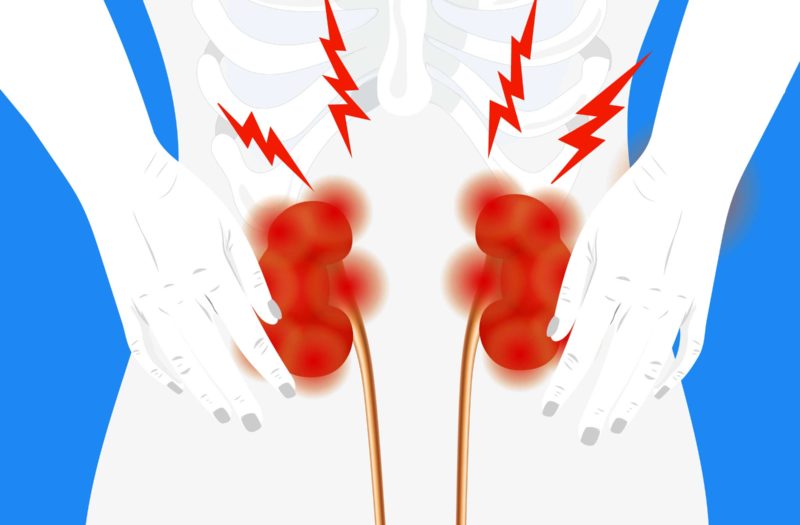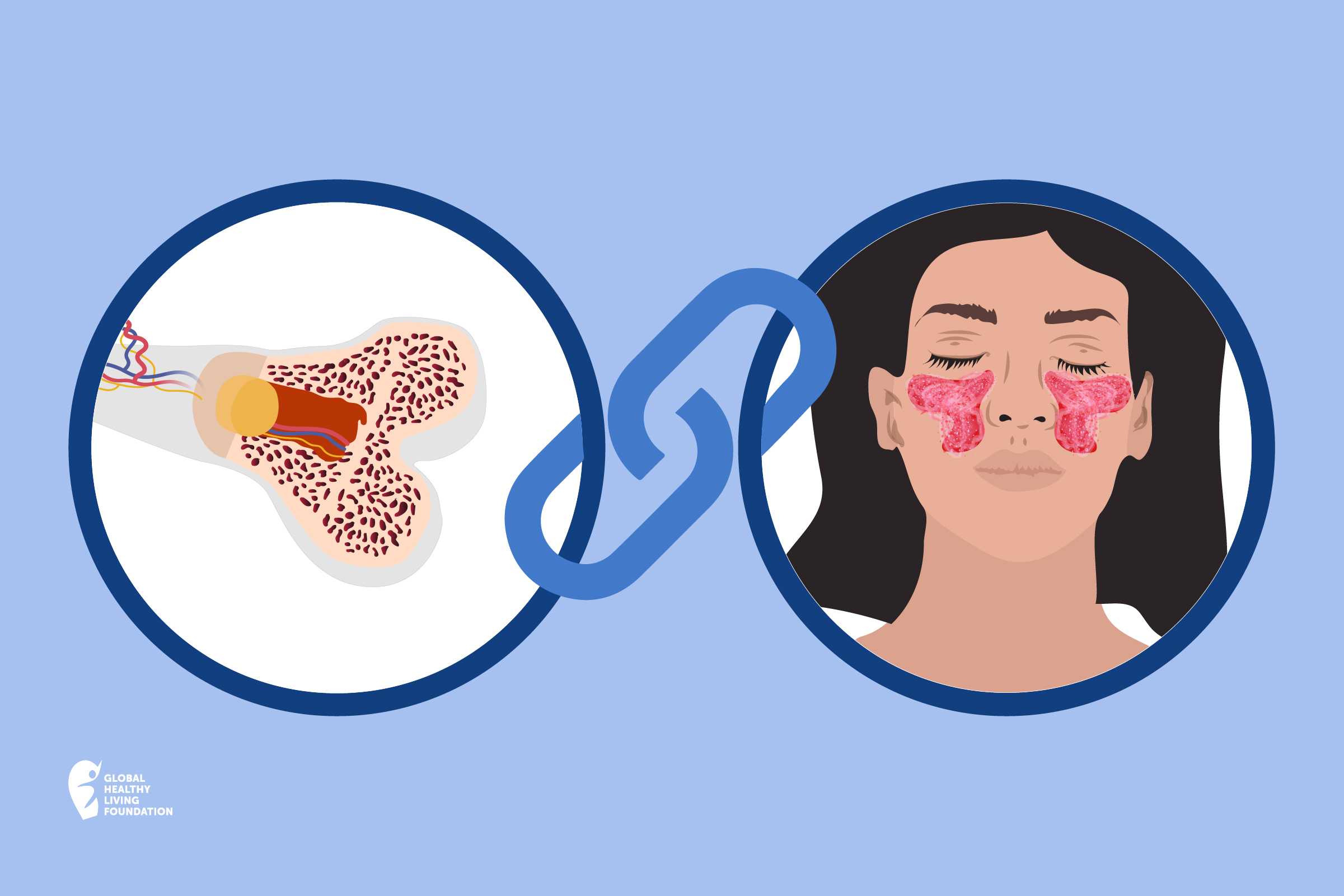Scleroderma renal crisis (SRC) is a life-threatening complication that can infrequently affect people who have systemic sclerosis (SSc), a multi-system autoimmune disease that affects the skin and other organs. It is thought to occur in about 10 percent of all patients with scleroderma.
Localized scleroderma is generally used to designate disease that is confined to the skin, while systemic sclerosis and scleroderma are generally used to indicate disease that is affecting organs throughout the body, but we will use them somewhat interchangeably in this article.
Although effects on the skin can be very visible, scleroderma and systemic sclerosis are not just a “skin disease.”
Systemic sclerosis causes all-over inflammation and thickening and tightening of connective tissue (like collagen), which can cause scarring and damage in different areas of the body, including the lungs, heart, gastrointestinal system, and, importantly, the kidneys.
Learn more here about general facts about scleroderma, including symptoms, diagnosis, and treatment.
How Scleroderma Affects the Kidneys
Scleroderma affects the blood vessels in the kidneys the same way it affects the blood vessels in the fingers, lungs, and other parts of the body, says Sapna Singh Patel, MD, a nephrologist who practices with Pacific Renal Associates in Long Beach, California and a clinical instructor of health sciences at UCLA David Geffen School of Medicine. Excess collagen is deposited in the arteries where it causes a narrowing of the blood vessels, which decreases the blood supply to kidneys.
This can cause very high blood pressure and relatively rapid kidney failure, if it is not addressed quickly, says Brett Smith, DO, a rheumatologist with Blount Memorial Physicians Group in Alcoa, Tennessee.
What Is Scleroderma Renal Crisis?
As a complication of systemic sclerosis, scleroderma renal — meaning kidney — crisis (SRC) is characterized by sudden hypertension (high blood pressure) and rapidly progressive renal failure, usually without previous significant kidney disease.
SRC can also involve hypertensive encephalopathy (brain dysfunction due to high blood pressure), congestive heart failure, and/or microangiopathic hemolytic anemia (loss of red blood cells).
While scleroderma renal crisis sounds scary, it is treatable. SRC used to be more prevalent, but it is becoming less common and more manageable, thanks to better ways to screen and treat the condition, says Ali Ajam, MD, a rheumatologist at The Ohio State University Wexner Medical Center in Columbus.
Early diagnosis of scleroderma is critical to reduce the risk of complications like SRC. “You have to be vigilant and take this condition seriously upfront,” says Robert Spiera, MD, a rheumatologist and director of the Vasculitis and Scleroderma Program at the Hospital for Special Surgery in New York City.
Treatment for scleroderma renal crisis is more likely to be effective when it is started early, before irreversible kidney damage has happened.
Fortunately, most people with scleroderma will never develop scleroderma renal crisis, says Dr. Smith.
Risk Factors for Scleroderma Renal Crisis
There are two general kinds of scleroderma: localized, which is generally limited to the skin, although it can affect bones and joints, and systemic, which can affect organs throughout the body.
Within systemic sclerosis, there are two main kinds: limited and diffuse (widespread). Most cases of scleroderma renal crisis occur in patients with diffuse systemic sclerosis. Data show it can affect anywhere from 10 to 25 percent of people with diffuse systemic sclerosis, while SRC is thought to affect just 1 to 2 percent of people with limited disease.
If scleroderma renal crisis occurs, it generally strikes early within the course of disease; up to 75 percent of cases occur within the first four years of diagnosis. It may sometimes even be the initial presenting feature of scleroderma.
Risk factors for scleroderma renal crisis include:
Skin involvement
The more skin that’s involved in scleroderma, the higher the risk of renal crisis, says Dr. Smith.
Taking steroid medication
Scleroderma renal crisis is more common in patients who are treated with glucocorticoids (a class of steroid medication used to lower inflammation); the risk rises with increasing doses.
Having anti-RNA polymerase III antibodies
Antibodies are markers in your blood made by your immune system that are associated with or can help identify different diseases. Anti-RNA polymerase III antibodies are associated with systemic sclerosis and can be an indicator of having more severe disease.
Cardiovascular and blood issues
Pericarditis (inflammation of the double-layered, sac-like structure around the heart, called the pericardium), pericardial effusion (accumulation of too much fluid in the pericardium), congestive heart failure, and new-onset anemia are all associated with SRC.
Signs and Symptoms of Kidney Problems in Scleroderma
Unfortunately, there may not be obvious signs of kidney problems until kidney disease is very advanced. You may notice headaches and blurred vision or blood in the urine.
However, many clues about scleroderma renal crisis will be detected through routine tests in the doctor’s office, including:
Rise in blood pressure
Most people with scleroderma renal crisis will have their blood pressure rise significantly above their baseline, says Dr. Smith. About 10 percent of people with scleroderma renal crisis will still have normal blood pressure, though their blood pressure levels are elevated relative to their own baseline, says Dr. Spiera. Keep in mind that you usually cannot feel when your blood pressure is elevated, so this is something that would be detected during a check-up. If you have risk factors or a history of high blood pressure, your doctor may recommend you take regular (daily or weekly) readings at home between visits.
Protein in the urine
Patients who have hypertension often have some protein in the urine, says Dr. Spiera.
Elevation of serum creatinine test
The kidneys normally eliminate creatinine from the body; a high level indicates trouble with kidney function.
Loss of glomerular filtration rate
This indicates the amount of filtering your kidney is performing per minute; the rate is calculated using age, gender, body size, and serum creatine. A low rate is a sign of impaired kidney function.
Microangiopathy (small blood vessel disease)
This can result in cardiac compromise (diminished ventricular function) and/or pulmonary edema (excess fluid in the lungs).
Changes in bloodwork
Patients may also have anemia and low platelets.
How Scleroderma Renal Crisis Is Diagnosed
Patients with scleroderma will have their blood tested for antibodies, which can help confirm a diagnosis as well as help doctors understand more about the nature and severity of the disease. Anti-RNA-polymerase III antibodies are found in one-third of patients with SRC. Dr. Ajam says that if you have these antibodies, it increases your likelihood of getting SRC, but it doesn’t mean for certain that you’ll get it. “It’s a possible indicator that someone might be at risk,” he says.
Checking blood levels of renin can be helpful, says Dr. Spiera. Renin is an enzyme that helps control your blood pressure and is made by special cells in your kidneys. It will usually be very elevated in these patients, he says. Urine tests are also done to check your blood and protein levels.
How Scleroderma Kidney Problems Are Treated
ACE inhibitor medication
The prognosis of SRC has dramatically improved thanks to the widespread use of a kind of blood pressure medication called angiotensin-converting enzyme inhibitors (ACEIs). SRC treatment aims to control blood pressure with ACEIs. You need to treat aggressively with ACEIs, pushing for the highest dose that’s tolerable by your blood pressure, says Dr. Spiera.
Once you’re diagnosed with scleroderma renal crisis, you’ll most often be hospitalized to start ACEI therapy. Typically, you’ll begin by taking a short-acting ACEI like captopril and rapidly adjust the dose to lower systolic blood pressure (the top blood pressure number) while avoiding too-low blood pressure. Once you’ve reached your blood pressure goal and your dose has been stabilized, long-acting ACE inhibitors can be substituted in equivalent doses.
If your blood pressure can’t be controlled with maximum doses of ACEI, a different kind of medication called a dihydropyridine calcium channel blocker can be added.
ACE inhibitors have changed the outcome of patients with scleroderma renal crisis. Before the use of these drugs, a one-year survival rate of patients with this disease didn’t exceed 10 percent. Patients treated with ACE inhibitors now can anticipate an 85 percent survival rate at one year and 65 percent survival rate at five years.
Still, while ACE inhibitors have helped improved the outcome of patients with scleroderma renal crisis, they don’t prevent the condition. They may increase the risk of death if used before you truly have scleroderma renal crisis.
Dialysis
Up to two-thirds of patients with scleroderma renal crisis may need dialysis. Dialysis is the process of removing excess water, solutes, and toxins from the blood in people whose kidneys can’t perform these functions naturally.
Half of SRC patients on dialysis will eventually get enough kidney function to stop dialysis, mainly in those whose blood pressure can be controlled with ACE inhibitors.
Kidney Transplant
If you can’t come off dialysis by nine months, it’s unlikely that you will, says Dr. Spiera. You may be deemed eligible for a kidney transplant. Kidney transplant recipients who have scleroderma however, have lower graft survival rates (meaning, no rejection of the transplant) compared to non-scleroderma patients. Recurrence of scleroderma renal crisis in the transplanted kidney is uncommon, but has been found, particularly in patients who had more aggressive disease before the transplant.
Get Involved in Scleroderma Research
If you are diagnosed with scleroderma, arthritis, or another musculoskeletal condition, we encourage you to participate in future studies by joining CreakyJoints’ patient research registry, ArthritisPower. ArthritisPower is the first-ever patient-led, patient-centered research registry for joint, bone, and inflammatory skin conditions. Learn more and sign up here.
Keep Reading
Bose N, et al. Scleroderma Renal Crisis. Seminars in Arthritis and Rheumatism. June 2015. doi: https://doi.org/10.1016/j.semarthrit.2014.12.001.
Cavazzana I, et al. Anti-RNA Polymerase III Antibodies: A Marker of Systemic Sclerosis With Rapid Onset and Skin Thickening Progression. Autoimmunity Reviews. June 2009. doi: http://dx.doi.org/10.1016/j.autrev.2009.02.002.
Hinchcliff M, et al. Managing Systemic Sclerosis and Its Complications. The Journal of Musculoskeletal Medicine. https://www.rheumatologynetwork.com/systemic-sclerosis/managing-systemic-sclerosis-and-its-complications.
Interview with Ali Ajam, MD, a rheumatologist at The Ohio State University Wexner Medical Center in Columbus
Interview with Brett Smith, DO, a rheumatologist with Blount Memorial Physicians Group in Alcoa, Tennessee
Interview with Lindsay S. Lally, MD, rheumatologist at the Hospital for Special Surgery in New York City
Interview with Robert Spiera, MD, a rheumatologist and director of the Vasculitis and Scleroderma Program at the Hospital for Special Surgery in New York City
Interview with Sapna Singh Patel, MD, a nephrologist who practices with Pacific Renal Associates in Long Beach, California and a clinical instructor of health sciences at UCLA David Geffen School of Medicine
Mouthon L, et al. Scleroderma Renal Crisis: A Rare but Severe Complication of Systemic Sclerosis. Clinical Reviews in Allergy & Immunology. April 2011. doi: http://dx.doi.org/10.1007/s12016-009-8191-5.
Scleroderma. American College of Rheumatology. https://www.rheumatology.org/I-Am-A/Patient-Caregiver/Diseases-Conditions/Scleroderma.
Scleroderma. Mayo Clinic. https://www.mayoclinic.org/diseases-conditions/scleroderma/symptoms-causes/syc-20351952.
Scleroderma (Systemic Sclerosis): How It Affects the Body. Scleroderma Foundation. https://www.scleroderma.org/site/SPageServer/?pagename=body_tool#.XjRscC2ZPGI.
Vaidya PN, et al. Scleroderma and Renal Crisis. Stat Pearls. https://www.ncbi.nlm.nih.gov/books/NBK482424.






